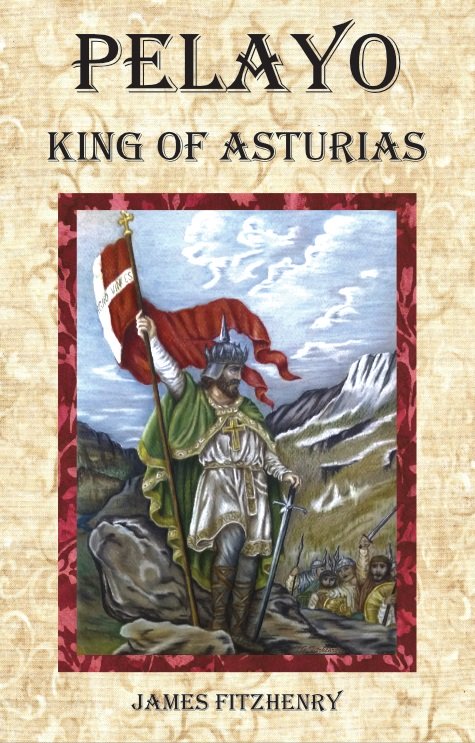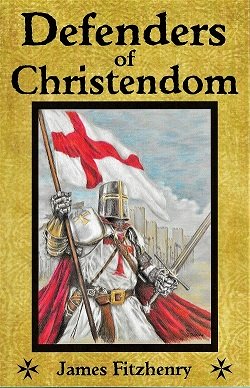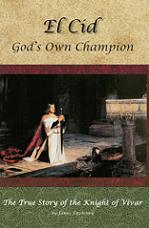Our Lady of the Candles
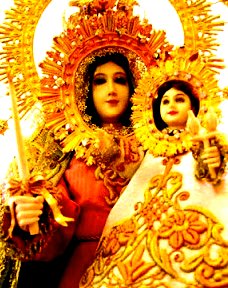
September 17: Our Lady of the Candles (15th Century)
When white men came to the Canary Islands for the first time, the natives presented them with a mystery that no one has ever solved, even to this day - the presence on the islands of a statue of Our Lady!
The natives had discovered the statue of Our Lady of the Candles in the year 1400, as it had been found in a cave by two shepherds who had entered the cave seeking refuge from a storm. Neither of them had ever seen a statue before, and so thought it was a living being.
The sheep would not enter the cave, seemingly out of fear of the statue, so at first the two shepherds motioned for the stranger to go away. When the statue did not move or respond, one of the men picked up a rock to throw at it. Instantly his arms stiffened so that he could not move, and his arms began to throb in pain. The other shepherd moved in close to the statue, and although it seemed to watch him, yet still it neither moved nor spoke. Puzzled, he took out his knife and tried to cut its finger - but instead of marking the statue, his own finger received the wound he had attempted to inflict, and then began to bleed profusely! Terrified, the two men fled the scene, leaving their sheep and everything else behind them.
Our Lady of the Candles
The men reported what had happened to their chief, relating their belief that a great god lived in the cave. The chief commanded them to bring this being to him. Overcoming their fear, the two shepherds returned to the cave and found the statue had not moved. When the first of them reached out to take hold of it, as soon as he had touched the statue he found his finger was instantly healed of the wound he had received.
The men reverently carried the statue to a house where their chief directed and tried to show it honor in the best way they knew how. A few nights later they were surprised to hear beautiful music, and to see strange beings, all glowing and alight, setting candles around the strange “god” and lighting them. The natives had never seen candles.
A special house was built for the statue, and for fifty years there was beautiful music, light, and a lovely fragrance surrounding the statue that no one could explain. The natives made offerings of fruit and flowers, and noted that the light “beings” kept the candles burning around the crude altar.
In 1520 a native boy was captured and taken to Spain; he returned after a few years, and told the natives about Christianity. When missionaries came, the people were prepared to receive them and the True Faith.
Christians who had recently arrived and lived on a nearby island, recognized whom the statue must represent. At first, they begged the natives of Tenerife to let them have it, though the pagan natives refused, claiming she had brought them good fortune. The Christians decided to steal the statue of Our Lady of the Candles, feeling it was only proper that it should be in Christian hands. They succeeded in their plan, and brought the statue to their church, setting it on the high altar and surrounding it with burning candles.
Returning in the morning, they found that the statue had turned its back to the congregation, and no amount of pulling could get it turned to the front again. A serious sickness then invaded the island, and, repentant and frightened, the Christians took the statue back. Surprisingly, the natives had not noticed that it had been taken. The incredible explanation was that another statue, and exact duplicate to Our Lady of the Candles, had stood in its place during the entire time the original had been away.
Not surprisingly, devotion to Our Lady of the Candles spread rapidly through Spanish countries to South America and the Philippines.
The original statue of Our Lady of the Candles was made of heavy reddish wood, which had never been identified. It is 3 ½ feet high. The eyes of the statue seem to follow the beholder, and the color of the cheeks sometimes changes. The hair is uncovered, golden and worn in braids. The Babe has a golden bird in its hands. Our Lady holds a candle in her hand.
Since there are no bees on the island, the candles are also a mystery. A few days before the feast of Candlemass in the year 1497, great quantities of a particularly pure wax were found at various places on the island. Several times since, the same thing has happened. People gather the wax and save it for pious souvenirs. It is sometimes found in the shape of loaves, weighing ten or twelve pounds. Another mystery concerns the candle stumps which even today are found near the cave. Some are set up on the rocks of the beach. Wax and wicks are of strange materials, which the good people of the neighborhood insist could only have come from heaven.
*from The Woman in Orbit
Marian Calendar, roman-catholic-saints.com
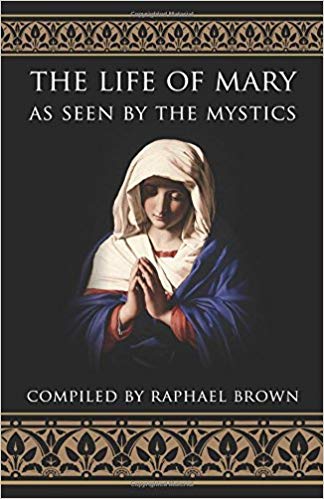
A masterpiece that combines the visions of four great Catholic mystics into one coherent story on the life of the Blessed Virgin Mary. Based primarily on the famous revelations of Ven. Anne Catherine Emmerich and Ven. Mary of Agreda, it also includes many episodes described in the writings of St. Bridget of Sweden and St. Elizabeth of Schenau. To read this book, therefore, is to share in the magnificent visions granted to four of the most privileged souls in the history of the Church.
In complete harmony with the Gospel story, this book reads like a masterfully written novel. It includes such fascinating details as the birth and infancy of Mary, her espousal to St. Joseph and her Assumption into Heaven where she was crowned Queen of Heaven and Earth.
For young and old alike, The Life of Mary As Seen by the Mystics will forever impress the reader with an inspiring and truly unforgettable understanding of the otherwise unknown facts concerning Mary and the Holy Family. Imprimatur. 280 pgs, PB
Have A Great Story About This Topic?
Do you have a great story? Have You Visited This Shrine? Share it!
Return to Marian Calendar September from Our Lady of the Candles
Return to Titles of Mary from Our Lady of the Candles
Return to Roman Catholic Saints Home Page from Our Lady of the Candles
Now Available!!
Pelayo's resistance initiated the nearly 800-year-long Reconquista to take back his country from the ruthless invader who had conquered his homeland and sought to erase his culture and his faith. His actions would lay the foundations of a Kingdom for Christ that would eventually reach around the world and spread the Catholic faith to millions of souls. Read more...
Please help us continue to bring high quality books to our readers at the lowest possible price! Click the link below! Thank you!
Now Available!
Catholic Vitality Publications presents . . .Brand new by
James Fitzhenry
Now in paperback!
Battles - Honor - Miracles! This
book is filled with amazing stories of little-known Catholic heroes presenting
spectacles of bravery and valor never exceeded in all the annals of history. read more. . .
Now Available for $24.95
Also available:
Catholic Vitality Publications
Roman Catholic books currently published by Catholic Vitality Publications:
El Cid, God's Own Champion
-the amazing true story of the life of Rodrigo Diaz, El Cid!
Available for only $22.95
St. Fernando III
A Kingdom for Christ
- King St. Fernando III, born 100
years to the month after the death of
the Cid. His life was filled with miracles
and many conquests!
Available now for $26.95
Discounts available for bulk
orders and for bookstore
retail sales! Just contact us

